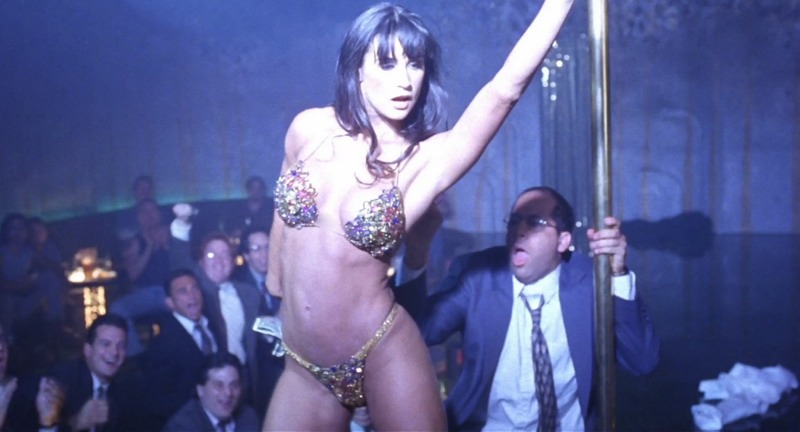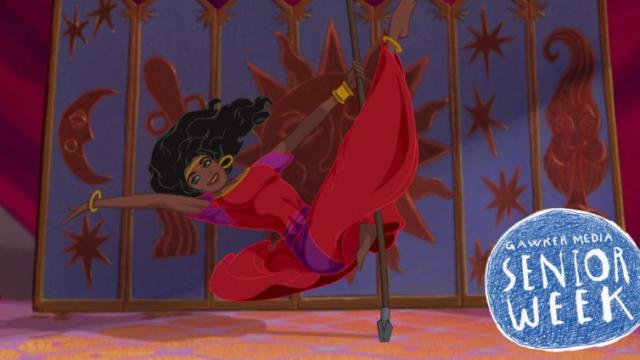I am a huge pole dancing fan. Something about the combination of dance and acrobatics, athleticism and grace, gets me every time. Plus it’s sexy as hell — but only if it wants to be, slut-shamers be damned.
Esmerelda joyfully takes to the pole, could not care less about your slut-shaming. (Image: Hunchback of Notre Dame, 1996)
I am also a huge physics fan, and pole dancing is chock-full of basic physics. Angular momentum, center of mass, friction, levers, static equilibrium — it’s all there. “This is straight-up Physics 101,” Rebecca Thompson, a physicist who heads up public outreach for the American Physical Society, told me after viewing some of the sample videos I sent her. “I could find a corollary for all these problems in any introductory physics textbook.” That is a physics class I would love to take.
Chances are when you you think of pole dancing, the mental picture you summon is this:

Demi Moore trained for months before strutting her stuff in Striptease (1996).
And you wouldn’t be wrong. It’s true that there is a strong pole dancing contingent among strippers and exotic dancers — hence the stereotype. But that’s a fairly recent trend, historically speaking. The practice, in some form, has been around for hundreds of years. There’s an Indian sport called mallakhamb (loosely translated: “pole gymnastics”), for instance, wherein the performer executes feats of strength and endurance using a wooden pole. The Chinese version used by acrobats features two or more poles, and the acrobats perform tricks while leaping from pole to pole, like this:
In the US, pole dancing acts were common in circuses and sideshows during the 1920s, but it’s generally accepted that the apparatus didn’t make it into actual strip clubs until 1968, when a woman named Belle Jangles took to the pole at the Mugwump Strip Club in Oregon. By the 1980s it was a fixture in striptease routines, and soon there were pole dancing competitions popping up all over the world.
The US Pole Dance Federation Championship (USPDF) held its first competition in 2009, complete with colourful, scanty outfits and 13cm heels for the performers, in keeping with those strip club roots. You may even recognise a couple of the basic moves from the Chinese acrobat video above.
But you don’t need those trappings to appreciate the strength and artistry involved. Here’s the 2009 USPDF champion (and former Cirque du Soleil aerialist), Jenyne Butterfly, performing at a pole dancing convention two years later. She’s barefoot and dressed in simple black workout clothes, the better to highlight her impressively toned physique and jaw-dropping athleticism:
Butterfly’s routine could provide some of those textbook physics problems should Thompson ever decide to teach this in a class. The basics of pole dancing are spinning around the pole (angular momentum) and climbing up the pole (friction and gravity).
A dancer will start by walking around the pole, and then throw herself (or himself) around it to generate angular momentum. According to Valerie Jamieson, editorial content director for New Scientist — who holds a PhD in physics — some poles are static, whiles others spin a little themselves, giving the performer an extra boost of angular momentum.
Calculating angular momentum is a classic introductory physics problem. Just multiply how much force is required to change an object’s motion (rotational inertia), by the rate at which it turns (angular velocity) — say, the number of revolutions per second. Because angular momentum is conserved, Butterfly spins faster when in a curled up, or tucked, position, than when she is leaning out away from the pole. It’s the same reason figure skaters spin faster on the ice with their arms pulled in, compared to when they throw their arms out wide.
When she’s climbing up the pole, or sliding down it, friction and gravity come into play. The classic physics problem usually involves going down a slide, but replace the slide with the pole, and you’ve got essentially the same exercise, according to Thompson. You’d need to know the coefficient of friction, which varies depending on the materials — and that includes not just the pole, but also skin and clothing. (The more slippery the pole, the harder it is to climb.) Multiply that by how hard she pushes against the pole, and you’ve calculated the frictional force involved.
Here’s the thing: You need friction, but not too much, and not too little — it depends on what move you’re trying to execute. “In some of those moves, people are hanging upside down by the crook of their knee, and then they slide down,” said Jamieson. The dancers can pull it off because they have such fine motor control: They contract their muscles and press into the pole to stick, then loosen their hold just enough to slide until they need to stop.
The skimpy outfits can be a boon in that regard because bare skin has just the right friction coefficient to help dancers stick to the pole, perhaps with a light dusting of resin on the hands and thighs to keep the sweat at bay. (Lotion or body oil is verboten if you’re going to work the pole.) That’s also an advantage of those stripper heels, typically sandals made of PVC or plastic. “They protect the top of your foot and give you extra friction as you’re climbing up the pole,” said Jamieson. And you’ll want that extra friction when you’re hanging upside down holding on with just your feet.
It might seem dramatic when the performer is hanging upside down on the pole — and it is, if only because he or she is relying on friction from some small part of their body to keep from falling. But in terms of the strength required, holding your body in a horizontal position as you grip the pole is much, much harder. It’s why gymnastics scoring awards more points for a back flip in a layout position than for a back flip in a tucked position. The former is much more difficult.
According to Thompson, this is a textbook static equilibrium problem in introductory physics, whereby students must calculate how much force is being applied by a hinge or a lever arm. In the case of pole dancing, you would measure where the centre of mass falls with respect to the pole, then multiply the dancer’s weight by whatever that radius is to determine how much total weight they actually have to hold up.
“Any time you have a lever, the farther out the centre of mass is, the more force is being applied,” she said. “So this is way harder than a chin up.” People with a higher centre of mass will find these horizontal moves a bit easier because that centre of mass will be closer to the pole.
Speaking of horizontal moves, I defy anyone not to be blown away when Butterfly does a little backwards horizontal “walk” in mid-air. That’s just crazy hard. My abs are sore just thinking about it.
What does it take to become a champion pole dancer? Killer core and upper body strength, for starters, plus a ridiculous degree of flexibility. Check out this training montage from Finnish pole dancer Oona Kivelä (a former gymnast):
In recent years, pole dancing has hit the mainstream, with lots of people — men and women of all ages — taking pole dancing classes for health and fitness, precisely because it offers one hell of a workout — and it’s fun to boot. I haven’t done so yet, mostly because (alas) I lack rhythm and flexibility. I’d probably look like Sandra Bullock resorting to martial arts moves while trying to learn beauty pageant choreography in Miss Congeniality:
Yeah, yeah, it’s not Soul Cycle. But I still think it’s cool. So there.
However sexy the performances might be, actually learning to pole dance is is anything but. You’ll be red-faced and sweaty most of the time, according to Jamieson, and even the most basic moves can be painful for beginners because of all that friction between your skin and the pole. “You can get these screeching noises as your skin sticks to the pole, and it burns as you slide down,” Jamieson (who took a few classes herself several years ago) said.
As Stuart Heritage wrote in the Guardian after taking a pole dancing class last year, “Walking home after an hour of pole dancing was like being kicked in the thigh by a horse and then subjected to a weaponised bout of chub-rub… By the end of the class, my thighs were covered in so many sores and friction burns that I had to nick some of my son’s nappy rash cream to soothe myself.”
That said, there’s still something of a social stigma attached to even the most innocent forms of pole dancing. Consider the controversy that erupted when Disney released Hunchback of Notre Dame in 1996. The character of Esmerelda is a street performer who does a flirtatious dance (ending with an impromptu pole dance) for onlookers — to the delight of many, and the morally indignant condemnation of a few. Given what we know of the roots of pole dancing, this is a perfect reasonable depiction. Yet a surprising number of people objected to such a “raunchy” scene in a kids’ movie.
Many of the women in Jamieson’s class — including a partner in a law firm — covered up their friction burns and bruises at work because they couldn’t admit to their hobby without being judged harshly by colleagues and clients. “It would have been more acceptable to look as if they were being abused at home rather than pole dancing,” said Jamieson. “And these were just fitness classes. We weren’t performing or anything.”
There’s really no doubt that pole dancing is just as physically challenging as gymnastics, for instance. The pole is just another apparatus, like the uneven or parallel bars. That’s why there’s been a marked movement away from the strip club image over the last few years, emphasising the athleticism and grace on display rather than the eroticism — along with petitions in 2012 and 2016 to approve pole dancing as an Olympic sport.
I understand that impulse; my favourite routines emphasise those elements too. But let’s not short-change the erotic element, either. “Let’s face it, all sorts of dancing is sexy as hell,” said Jamieson. “Dancing can be sexy as well as beautiful and athletic, and so what?” There’s no reason pole dancing should be any different. Be as sexy (or not) as you wanna be.
I’ll close with a few more of my favourite online videos. Here’s Michelle Stanek with a beautifully choreographed, sensual jungle-themed routine:
Here’s one of my all-time favourites: A “vertical tango” that won the gold medal at the 2010 Festival Mondial du Cirque de Demain in Paris:
Finally, we gotta give the guys a chance to show their stuff, so here’s Australian acrobat Hamish McCann (one-half of acrobatic duo The English Gents) with his late-night cabaret pole routine, paying winking homage both to striptease and to Singing in the Rain. There are several versions floating around on YouTube, of varying quality, but this raw Facebook Live clip gives you a ringside seat.
